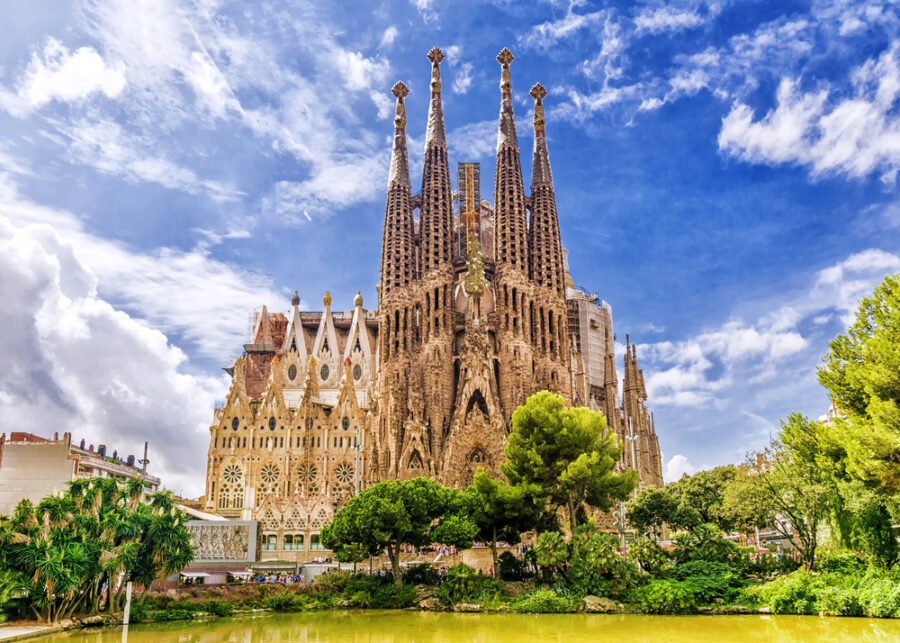You can scarcely turn a corner in Europe without coming across a magnificent monument. In fact, the continent is brimming with beautiful structures. Many of Europe’s most famous landmarks, such as the Eiffel Tower in Paris, the Colosseum in Rome, and the Leaning Tower of Pisa, do not need to be introduced.
With so many iconic landmarks scattered across Europe, you won’t be short on options for your next big European adventure—the only difficult part will be choosing which one to see first. From 5,000-year-old monoliths to a quirky work-in-progress basilica, each of these locations is rich in architecture, artwork, and history.
We’ve compiled a list that includes 6 of Europe’s most iconic landmarks, each deserving of a position on your European bucket list.

Eiffel Tower, Paris
The 1,063-foot-high Eiffel Tower, which rises over the southwest side of the city from its base in the 7th arrondissement, has become a symbol synonymous not just with Paris, but with France as a nation.
It’s difficult to believe that the open-lattice, wrought-iron tower, designed by French architect Gustave Eiffel as a temporary yet groundbreaking project for the 1889 World’s Fair, was supposed to be dismantled after just 20 years.
Indeed, the tower’s odd aesthetic sparked widespread public outrage, but it was eventually saved from removal, owing partly to its functional value as a telecommunications tower. Today, the city’s iconic spire is a permanent feature on the Parisian skyline, marking one of Europe’s—and the world’s—most recognizable monuments.
The tower is possibly even more stunning at night when hundreds of glittering lights illuminate it intermittently. France is famous for its Eiffel Tower views, so take in some of the best from the Palais de Chaillot esplanade, which is just over the Seine River.
Colosseum, Rome
The Colosseum in Rome is not just one of Europe’s most recognized structures, but it is also a lasting emblem of the ancient world. Indeed, the scale of the Colosseum is as impressive now as it was over two thousand years ago, under the order of Emperor Vespasian in AD 72.
It was eventually finished in 80AD by his son and successor Titus and was known as the Flavian Amphitheatre.
The gigantic stone and concrete building, located just east of Rome’s relic-filled Palatine Hill, stands 160 feet tall and has a circle of 1,788 feet—a mind-boggling magnitude for the times.
Consider it while wandering its perimeters, noting the travertine-clad walls and three-tiered seating levels, each crowned by a different column design (Doric, Ionic, and Corinthian). It’s worth noting that a vast retractable velarium (awning) originally protected spectators from the weather.
Inside the elliptical bowl’s engineering wonder, you may envision old images from gladiators and wild creatures that once battled here at the height of the Roman Empire, where 50,000 spectators witnessed horrific and gory fight scenes.
Parthenon, Athens
The cream-colored, marbled Parthenon temple, another European antiquity symbol, is the crowning splendor of Athens’ rocky Acropolis summit (the sacred heart of the ancient city). The picture-perfect temple has a symmetrical colonnade of Doric columns and a belvedere with a view of Athens.
The monument was commissioned by the Athenian statesman Pericles to honor Athena Parthenos, the patron goddess of Athens (a colossal gold-and-ivory statue bearing her likeness was formerly held within) and to serve as the city’s treasury. Much of what is left of the temple now dates from the mid-fifth century BC.
A hard hike on foot to the Acropolis represents a trip back in time to the birthplace of Western Civilization. The 2,500-year-old Parthenon, perched on the pinnacle of the Acropolis, reigns supreme among the scattered ruins of antiquity.

La Sagrada Familia, Barcelona
La Sagrada Familia in Barcelona, the unprecedented achievement and preoccupation of legendary Spanish architect Antoni Gaudi, is one of Europe’s most recognized structures, not to mention one of the finest cathedrals to ever grace the earth.
The neo-Gothic/Art Nouveau Basilica, one of a kind and built on a larger-than-life scale, has remained a work in progress for more than a century since construction began in 1882.
The façade is a spectacular display of ornate spires, turrets, carvings, and sculptures that reach skyward to heights of 566 feet, making it one of the most magnificent destinations in Spain. Zoom in to see exquisite and imaginative features carved in stone, such as flora and fauna, nativity scenes and biblical themes, and gargoyles and dragons.
Contemplating the structure’s towering interior, with gigantic, twisting pillars arching toward the center nave in a sight suggestive of a forest canopy, may just convert the unconvinced (there’s room for 13,000 seated attendees to sit and reflect).
Finally, the long-awaited completion date for La Sagrada Familia is approaching: 2026, a century after Gaudi’s death (he is interred in the crypt underneath).
Stonehenge, UK
This ring of ancient megalithic pillars in the English countryside of the Salisbury Plain has fascinated enthusiastic observers for generations. With roots dating back to 3000 BC, the site is often regarded as the most important prehistoric monument in Britain. However, concerns about the significance of the site and its construction linger today.
According to some historians, it was an astronomical observatory (the stones are exactly aligned with the solstice sunrise/sunset). Others say it was a place of ritual burial. The large bluestone and sarsen stones themselves (weighing up to 45 tons) are the most unusual part of the site for engineers, having been transported long distances from as far away as neighboring Wales.
See what echoes of the past are revealed to you on a visit to the renowned archaeological site—just keep in mind that you’ll have to contemplate the strange monoliths from afar, since touching the stones is not authorized.
Leaning Tower of Pisa, Pisa
This odd bell tower for the Pisa Cathedral in Pisa, Italy, dates from 1173 and was lopsided practically from the start due to the uneven settling of its foundation in the soft ground below.
Architects have tried (in vain) to compensate for the lean throughout the ages, but 850 years later, the 185-foot-high Leaning Tower of Pisa still leans (to around 4 degrees off the vertical).
But regrettably, that is what has made it one of Italy’s most recognized landmarks and one of Europe’s most iconic monuments.
Fortunately, efforts to maintain the eight-story medieval tower with its white-marble arcades have helped ensure that tourists may still ascend the 251 inner stairs today. From the summit, you’ll have a great view of the cathedral complex and the surrounding Tuscan landscape.
You might also like: 21 Countries That Americans Can Visit But Only Vaccinated














